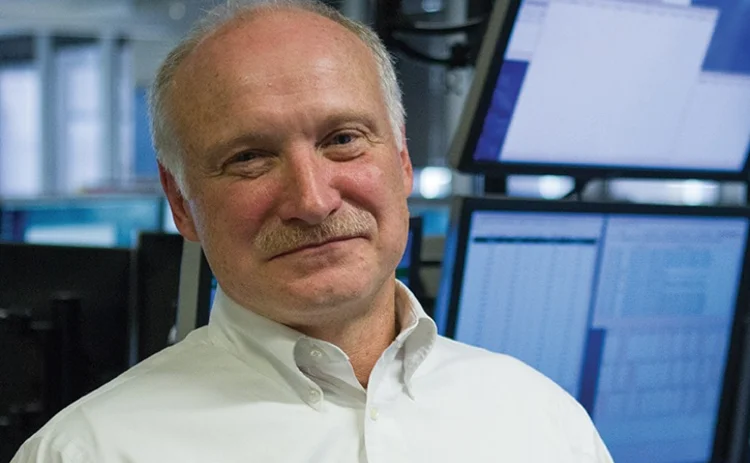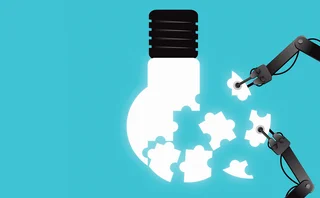Eternally Internal: WH Trading CTO Mike Madigan
Mike Madigan has spent nearly 15 years at Chicago-based WH Trading, building the proprietary trading firm’s technology from the ground up.

The first thing you see upon arriving at WH Trading’s office is the ping pong table.
The table-tennis court sits alone on the 5th floor, roughly three feet outside the elevator doors, making you immediately question whether or not you’re in the right place at all.
WH Trading’s company crest, which hangs on the wall opposite the glass door entrance of the firm, is the only indication that you’ve arrived at the headquarters of a capital markets firm. The table resembles a forgotten piece of furniture, like an old couch or mattress the tenants have left on the curbside for the garbage truck to pick up.
So you ask about the ping pong table because, well, you can’t not ask about the ping pong table.
It transpires that it actually started its life inside the firm’s office. Employees, looking for a way to blow off steam, would play against each other right next to the trading floor. Naturally, things got competitive and loud.
“We know ours is faster than theirs. We’ve used it. There is no question about it. We take a lot of the pains to make sure that our stuff is performing really well and giving these guys the functionality that they really want.” Mike Madigan, WH Trading
The building’s other tenants didn’t take too kindly to their neighbors’ thumping and banging while playing a game more suited for a bar room than a board room, so complaints were filed. The firm suggested moving the table out to the elevator lobby, but the building supervisors didn’t approve of the idea.
So the table remained, and after a while the complaints resumed, because games were always competitive—this is a firm that has a locker-room for its employees that’s painted in Wesleyan University colors, the alma mater of the firm’s founder, Will Hobert, who played hockey for the Cardinals and then spent over two years sailing around the world on various boats. Competition is built into the very fiber of WH Trading.
The building supervisors eventually relented, allowing them to move the table to the elevator lobby, where it sits today. The empty space allowed games to evolve into a hybrid version of ping pong where players play the ball off walls, making the space feel more like a ping pong arena than an elevator lobby.
And so as Mike Madigan, CTO for WH Trading, sits at his desk and tells you why the Chicago-based proprietary trading firm only outsources, from his estimate, approximately 10 percent of its total technology, you understand. This is the same place that can’t play a quiet game of ping pong. Do you really expect them to use substandard software when they can do it better themselves?
“We know ours is faster than theirs. We’ve used it. There is no question about it,” says Madigan of vendor technology. “We take a lot of the pains to make sure that our stuff is performing really well and giving these guys the functionality that they really want.”
Build It
Madigan has always been the type to develop his own solutions to problems. There were plenty of opportunities at Northrop’s defense systems division where Madigan first worked out of college. Ronald Reagan was the US president at the time, and there seemed to be no limit on the military budget, meaning plenty of work for Madigan and his colleagues.
Madigan’s department worked on the high-voltage, high-current power supplies that drive fighter jets’ electronic countermeasures, such as radar jammers and devices used to confuse heat-seeking missiles. He worked on electromagnetic modeling, doing finite element analysis on power supplies to see where electric stress was occurring.
The equipment was put in environmental testing chambers to ensure it could withstand the extreme conditions it would be exposed to on fighter jets. When Madigan got there, electrical engineers recorded all the readings from the different instruments by hand as they tested the equipment.
“My boss and I looked at each other and said that there had to be a better way to do this,” Madigan says. “I started writing programs on their HP workstations and data-acquisition equipment that essentially automated all of that. I worked with an electrical engineer who created an interface into the testing chambers so that I could control it from the computer. I could set the temperature and pressure ranges by sending signals to the circuit he created, and then collect all the data electronically in a data acquisition unit. I’d run my program, and everybody could walk away. It would collect all the data, and it would plot it in real time.”
Take a Chance
The mentality of going out and building your own systems from scratch stayed with Madigan throughout his career, especially in his current role at WH Trading. He is in his 15th year with the firm, which specializes in trading futures and options in US, European and Asian markets.
It was 2000 when he first received a call from WH Trading founder Hobert gauging his interest in joining. The two had worked together in the early 1990s at Cooper Neff and Associates, an options market-making firm that was eventually purchased by Banque National de Paris (BNP).
Hobert left in 1994 to start his own firm, which at the time meant just him trading foreign-exchange (FX) options down in the Chicago Mercantile Exchange (CME) pits. By 2000, WH Trading had 10 traders and was interested in doing more work with computers, believing the future was in electronic trading. It was a risk–reward decision for Madigan, who was happy in his current role as a senior systems analyst at Archelon LLC, a proprietary trading firm. He decided to make the move in April 2001, essentially building WH Trading’s infrastructure from the ground up.
Early Days
The technology was minimal at the beginning, to say the least. Madigan says he remembers there only being roughly three computers at the firm when he started, none of which were networked. The first goal was to get the computers connected and set up a few Globex terminals so traders could do some hedging off the floor.
The next step was to work with Steven Moffitt, a PhD statistician who had been hired as a consultant, to develop an options model. Eventually, the firm decided to get into electronic market-making. Without a technology team to build a system, Madigan knew he’d have to outsource that function.
He chose RTS, but tied WH Trading’s models to the vendor’s system, meaning the theoretical values from WH Trading’s models were pumped through RTS software so the traders could see them.
It was a unique time in the industry, as there was pressure on exchanges to resist the move to electronic trading, according to Madigan. The Chicago Board Options Exchange had a hybrid model that allowed firms to trade electronically only if they were standing in the pit. This meant WH Trading would send a trader into the pit with a laptop to physically stand there while they traded electronically.
The firm soon realized that electronic trading, at the time, had more potential in the futures market. At this point, Madigan had a larger team and was able to develop models to trade some CME products. As the firm grew, trading expanded to other products, eventually reaching Europe.
It was at this point that Madigan decided to completely move the futures operation in-house. There was no need to remain with RTS thanks to the development work Madigan’s team had done.
“We knew we were faster, we had better features than RTS, and that we could support it,” Madigan says. “Every time there was a bug in RTS, you had to go back to the vendor and their sense of priority was not the same as yours. All the futures stuff was all on our own code base. We had set up our own networks and datacenters and everything elsewhere.”
WH Trading still kept RTS when it came to options due to the complexity of the product, but that changed too once it had created enough options software in-house.
Keep it Internal
Fast forward to the present day and the majority of WH Trading’s technology, including the back office, is done in-house. Madigan admits that his desire to avoid vendors might come down to an attachment to the technology. This is, after all, his baby. He has developed all the firm’s trading applications. When you’ve been tweaking and upgrading a system for over a decade, you tend not to want a third party to meddle with it.
But it’s more than just an emotional attachment to models and platforms, according to Madigan. There is no way the firm could get the customization it has now by outsourcing the development.
“Our developers come out and sit here with the traders and talk about the features they want,” he explains. “We have a meeting every month with the two main owners where we sit and talk about what we need and the problems the traders are having. There is a direct connection, a very open channel, between the developers and the traders. I think at the end of the day, we get a better product that really gives these guys the functionality that they want.”
Madigan declined to get into specifics around enhancements that have come about from conversations between traders and developers, as would be expected of someone who works at a proprietary trading firm, but says a lot of the upgrades stem from the ways traders want to hedge or work orders, such as new quoting or hedging strategies they feel will give them an edge.
Exceptions to the Rule
Madigan, however, does not completely shun outsourcing—he’s just very particular about when and where he uses it. For instance, WH Trading does outsource some servers in London, Frankfurt and Singapore for the firm’s European and Asian trading business. Outsourcing is also an option whenever someone is interested in getting involved in a new exchange. When it comes to expanding into new territory, it’s about time-to-market, according to Madigan.
“We want to get there fast. I don’t want to buy circuits and datacenter space before we even know if it’s going to be a profitable business,” he says.
Outsourcing providers are mindful of this too, Madigan says, offering month-to-month contracts. It’s a lesson Madigan says he learned during the financial crisis when he signed a three-year contract on some hardware before the economy went south.
WH Trading won’t sign any long-term contracts now, which allows the firm to be agile in different markets. If a new exchange turns out to be particularly profitable, Madigan says they’ll look to develop the necessary software and hardware to bring it in-house eventually.
“That gives us the flexibility to try a new place, stick our toe in the water and see if we can make money. If we can’t, we pull out and we’re not locked in for a year,” Madigan says. “Outsourcing makes a lot of sense from that point of view.”
Culture
Madigan’s views on outsourcing aren’t for everyone. A big bank or asset manager couldn’t eliminate the bulk of its vendor relationships and choose to build its technology internally.
But his philosophy speaks to the overall attitude at WH Trading. With just over 70 employees, it’s not the type of place one gets lost in the shuffle. Everyone knows everyone, from the founder to the most junior programmer.
Case in point: Every Friday, Madigan wears a Hawaiian shirt to work, an ode to the 1999 cult film Office Space. What started as a joke has become such a big part of the firm that Madigan says his colleagues expect it every week. “Now if I don’t wear one, these guys get all crazy,” he jokes.
That type of culture is what Madigan loves about WH Trading, and what has kept him away from the big banks. Office politics and boardroom bureaucracy is what Madigan has sought to avoid throughout his career.
So whether it’s building a new model for a product on the CME or playing someone in the makeshift ping pong arena, Madigan is all about completing the task at hand.
“Give me my job to do, and I’ll get it done,” he says. “That’s what I like about WH Trading. We know what we’ve got to do and we just make it happen.”
Mike Madigan Fundamental Data
Name: Mike Madigan
Hometown: Mount Prospect, Ill
Age: 55
Title: CTO, WH Trading
Education: BS in physics from Illinois State University; MS in physics from Illinois Institute of Technology
Hobbies: Biking, camping, backpacking, canoeing, wood working
Family: Madigan and his wife, Carol, have seven children.
Only users who have a paid subscription or are part of a corporate subscription are able to print or copy content.
To access these options, along with all other subscription benefits, please contact info@waterstechnology.com or view our subscription options here: https://subscriptions.waterstechnology.com/subscribe
You are currently unable to print this content. Please contact info@waterstechnology.com to find out more.
You are currently unable to copy this content. Please contact info@waterstechnology.com to find out more.
Copyright Infopro Digital Limited. All rights reserved.
As outlined in our terms and conditions, https://www.infopro-digital.com/terms-and-conditions/subscriptions/ (point 2.4), printing is limited to a single copy.
If you would like to purchase additional rights please email info@waterstechnology.com
Copyright Infopro Digital Limited. All rights reserved.
You may share this content using our article tools. As outlined in our terms and conditions, https://www.infopro-digital.com/terms-and-conditions/subscriptions/ (clause 2.4), an Authorised User may only make one copy of the materials for their own personal use. You must also comply with the restrictions in clause 2.5.
If you would like to purchase additional rights please email info@waterstechnology.com
More on Emerging Technologies
LSEG’s private funds platform, Microsoft’s new datacenter, and more
The Waters Cooler: New private markets solutions, M&A activity, and a sprinkle of DLT in this week’s news roundup.
BlueMatrix acquires FactSet’s RMS Partners platform
This is the third acquisition BlueMatrix has made this year.
Waters Wavelength Ep. 331: Cresting Wave’s Bill Murphy
Bill Murphy, Blackstone’s former CTO, joins to discuss that much-discussed MIT study on AI projects failing and factors executives should consider as the technology continues to evolves.
FactSet adds MarketAxess CP+ data, LSEG files dismissal, BNY’s new AI lab, and more
The Waters Cooler: Synthetic data for LLM training, Dora confusion, GenAI’s ‘blind spots,’ and our 9/11 remembrance in this week’s news roundup.
Chief investment officers persist with GenAI tools despite ‘blind spots’
Trading heads from JP Morgan, UBS, and M&G Investments explained why their firms were bullish on GenAI, even as “replicability and reproducibility” challenges persist.
Wall Street hesitates on synthetic data as AI push gathers steam
Deutsche Bank and JP Morgan have differing opinions on the use of synthetic data to train LLMs.
A Q&A with H2O’s tech chief on reducing GenAI noise
Timothée Consigny says the key to GenAI experimentation rests in leveraging the expertise of portfolio managers “to curate smaller and more relevant datasets.”
Etrading wins UK bond tape, R3 debuts new lab, TNS buys Radianz, and more
The Waters Cooler: The Swiss release an LLM, overnight trading strays further from reach, and the private markets frenzy continues in this week’s news roundup.








